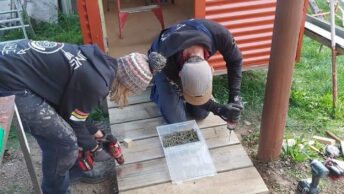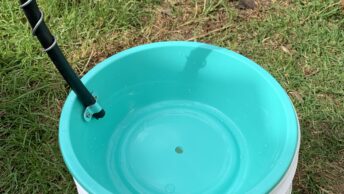Our landfill waste was down to a 20L bin every 2/3 weeks, but once we acquired Diesel, our cute (big) puppy, we suddenly had a whole wheelie bin full of poop every week. Big dogs equal big poops. One medium-sized dog produces about 180 kilograms of poo a year, and with about 9 million dogs in Australia, it can really start to pile up. Oh and of course you can use this for any pet waste!
We decided we didn’t want to be part of the problem, and after searching on the internet found some inspiration and decided to go for it. Since we had a large dog that was only going to get bigger we went for the bigger storage option – a 220 litre olive barrel. Keep an eye out at the side of the road, sometimes they get dumped!
When siting the digester, have a good think as to where you should put it – we put ours at the back of the garden next to the compost bins. This was convenient for us when cleaning up the yard to quickly make deposits, and the soil was likely to be deep enough with no obstructions. Another potential spot could have been near our back gate to drop in waste after a walk. Since you’ll be using this every day, site wherever makes sense for you so that you can get the job done quickly.
What you need:
- 220 litre olive barrel or similar – $20
- EnsoPet starter to build up the microbes for digestion – $14
- Pebbles/rocks for drainage – FREE
- Drill with approx. 10mm drill bit (big enough for a fat worm!)
- Hacksaw
- Spade/Posthole digger
Project Total – $34
Instructions:
Drill holes from the bottom to half way up the barrel, we don’t want any smell seeping out from the ground.

Cut off the bottom of the barrel, so rocks can be placed inside for drainage.

Find a suitable spot for your barrel to go into the ground. Think of what type of soil and how deep you’ll be digging into. Now dig the hole! I ended up cutting a third off the height of the barrel since I hit rocky subsoil and couldn’t go any deeper.

Add the pebbles/rocks for drainage.

Make your first deposit with a sprinkle of EnsoPet starter and some water. This only needs to get added once a week or so and should last a long time.

Tip: You could also add some compost worms to speed up the initial phase of decomposition. We didn’t have any so just let the system do it’s thing. After a number of weeks worms had found their way in and numbers grew rapidly. Unfortunately we no longer have our pup, but the many deposits that built up have composted into unrecognisable humus.





